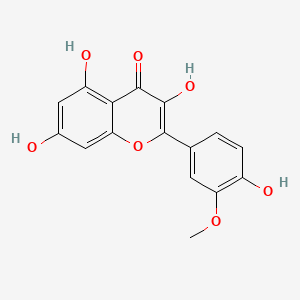| MeSH term | MeSH ID | Detail |
|---|---|---|
| Hemolysis | D006461 | 131 associated lipids |
| Breast Neoplasms | D001943 | 24 associated lipids |
| Inflammation | D007249 | 119 associated lipids |
| Cataract | D002386 | 34 associated lipids |
| Body Weight | D001835 | 333 associated lipids |
| Edema | D004487 | 152 associated lipids |
| Cell Transformation, Neoplastic | D002471 | 126 associated lipids |
| Hypertension | D006973 | 115 associated lipids |
| Parkinson Disease | D010300 | 53 associated lipids |
| Cystitis | D003556 | 23 associated lipids |
Isorhamnetin
Isorhamnetin is a lipid of Polyketides (PK) class. Isorhamnetin is associated with abnormalities such as Facial Hemiatrophy, Colitis, endothelial dysfunction, Morphologically altered structure and Diabetes. The involved functions are known as enzyme activity, Methylation, Anabolism, Binding (Molecular Function) and Vmax. Isorhamnetin often locates in Body tissue, Cytoplasmic, Mucous Membrane, Cytoplasm and Human tissue. The associated genes with Isorhamnetin are CSK gene, RPS6KA3 gene, Mitogen-activated protein, NCF1 gene and Chromatin. The related lipids are Fatty Acids, Phosphatidylserines and Palmitates. The related experimental models are Mouse Model, Xenograft Model and Streptozotocin Diabetes.
Cross Reference
Introduction
To understand associated biological information of Isorhamnetin, we collected biological information of abnormalities, associated pathways, cellular/molecular locations, biological functions, related genes/proteins, lipids and common seen animal/experimental models with organized paragraphs from literatures.
What diseases are associated with Isorhamnetin?
Isorhamnetin is suspected in Colitis, endothelial dysfunction, Morphologically altered structure, Facial Hemiatrophy, Diabetes, Hemorrhagic diarrhea and other diseases in descending order of the highest number of associated sentences.
Related references are mostly published in these journals:
| Disease | Cross reference | Weighted score | Related literature |
|---|
Possible diseases from mapped MeSH terms on references
We collected disease MeSH terms mapped to the references associated with Isorhamnetin
PubChem Associated disorders and diseases
What pathways are associated with Isorhamnetin
There are no associated biomedical information in the current reference collection.
PubChem Biomolecular Interactions and Pathways
Link to PubChem Biomolecular Interactions and PathwaysWhat cellular locations are associated with Isorhamnetin?
Visualization in cellular structure
Associated locations are in red color. Not associated locations are in black.
Related references are published most in these journals:
| Location | Cross reference | Weighted score | Related literatures |
|---|
What functions are associated with Isorhamnetin?
Related references are published most in these journals:
| Function | Cross reference | Weighted score | Related literatures |
|---|
What lipids are associated with Isorhamnetin?
Related references are published most in these journals:
| Lipid concept | Cross reference | Weighted score | Related literatures |
|---|
What genes are associated with Isorhamnetin?
Related references are published most in these journals:
| Gene | Cross reference | Weighted score | Related literatures |
|---|
What common seen animal models are associated with Isorhamnetin?
Mouse Model
Mouse Model are used in the study 'Chemopreventive activity of plant flavonoid isorhamnetin in colorectal cancer is mediated by oncogenic Src and β-catenin.' (Saud SM et al., 2013).
Xenograft Model
Xenograft Model are used in the study 'Isorhamnetin inhibits proliferation and invasion and induces apoptosis through the modulation of peroxisome proliferator-activated receptor γ activation pathway in gastric cancer.' (Ramachandran L et al., 2012).
Streptozotocin Diabetes
Streptozotocin Diabetes are used in the study 'Plant flavonol isorhamnetin attenuates chemically induced inflammatory bowel disease via a PXR-dependent pathway.' (Dou W et al., 2014).
Related references are published most in these journals:
| Model | Cross reference | Weighted score | Related literatures |
|---|
NCBI Entrez Crosslinks
All references with Isorhamnetin
Download all related citations| Authors | Title | Published | Journal | PubMed Link |
|---|---|---|---|---|
| Seo S et al. | Isorhamnetin Inhibits Reactive Oxygen Species-Dependent Hypoxia Inducible Factor (HIF)-1α Accumulation. | 2016 | Biol. Pharm. Bull. | pmid:27803454 |
| Ford CT et al. | Identification of (poly)phenol treatments that modulate the release of pro-inflammatory cytokines by human lymphocytes. | 2016 | Br. J. Nutr. | pmid:26984113 |
| Liu JL et al. | Optimization of Microwave-Assisted Extraction Conditions for Five Major Bioactive Compounds from Flos Sophorae Immaturus (Cultivars of Sophora japonica L.) Using Response Surface Methodology. | 2016 | Molecules | pmid:26950107 |
| Chen JH et al. | Estrogenic effects of flavonoid components in Xiaoyao powder. | 2016 | Genet. Mol. Res. | pmid:26909969 |
| Simirgiotis MJ et al. | Fast Detection of Phenolic Compounds in Extracts of Easter Pears (Pyrus communis) from the Atacama Desert by Ultrahigh-Performance Liquid Chromatography and Mass Spectrometry (UHPLC-Q/Orbitrap/MS/MS). | 2016 | Molecules | pmid:26784158 |
| Ma YC et al. | An effective identification and quantification method for Ginkgo biloba flavonol glycosides with targeted evaluation of adulterated products. | 2016 | Phytomedicine | pmid:27002408 |
| Park JY et al. | Isorhamnetin-3-O-Glucuronide Suppresses JNK and p38 Activation and Increases Heme-Oxygenase-1 in Lipopolysaccharide-Challenged RAW264.7 Cells. | 2016 | Drug Dev. Res. | pmid:27113811 |
| Jnawali HN et al. | Antituberculosis Activity of a Naturally Occurring Flavonoid, Isorhamnetin. | 2016 | J. Nat. Prod. | pmid:26974691 |
| Lau AJ et al. | Cell-based and in silico evidence against quercetin and structurally-related flavonols as activators of vitamin D receptor. | 2016 | J. Steroid Biochem. Mol. Biol. | pmid:27041117 |
| Liu H et al. | Solid-phase extraction of flavonoids in honey samples using carbamate-embedded triacontyl-modified silica sorbent. | 2016 | Food Chem | pmid:26988475 |
